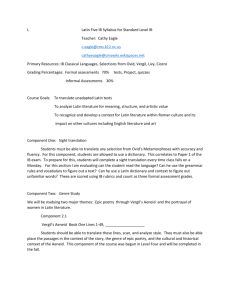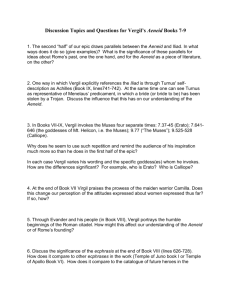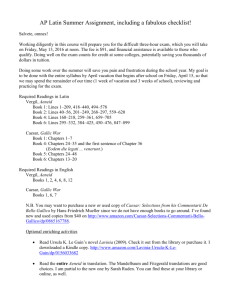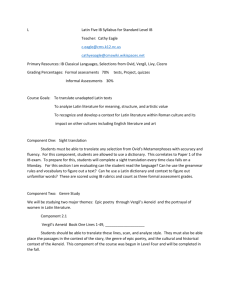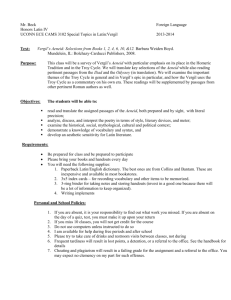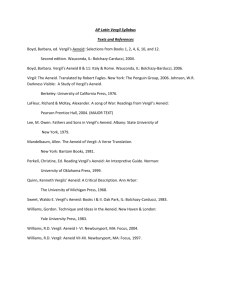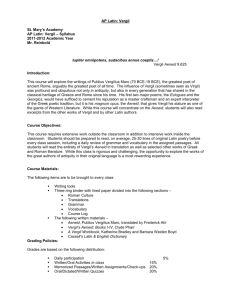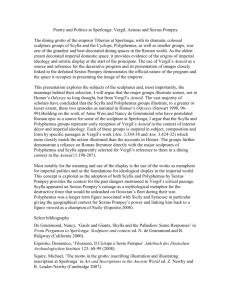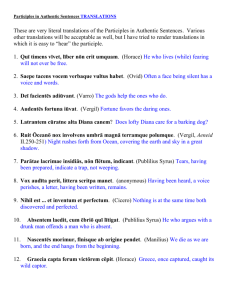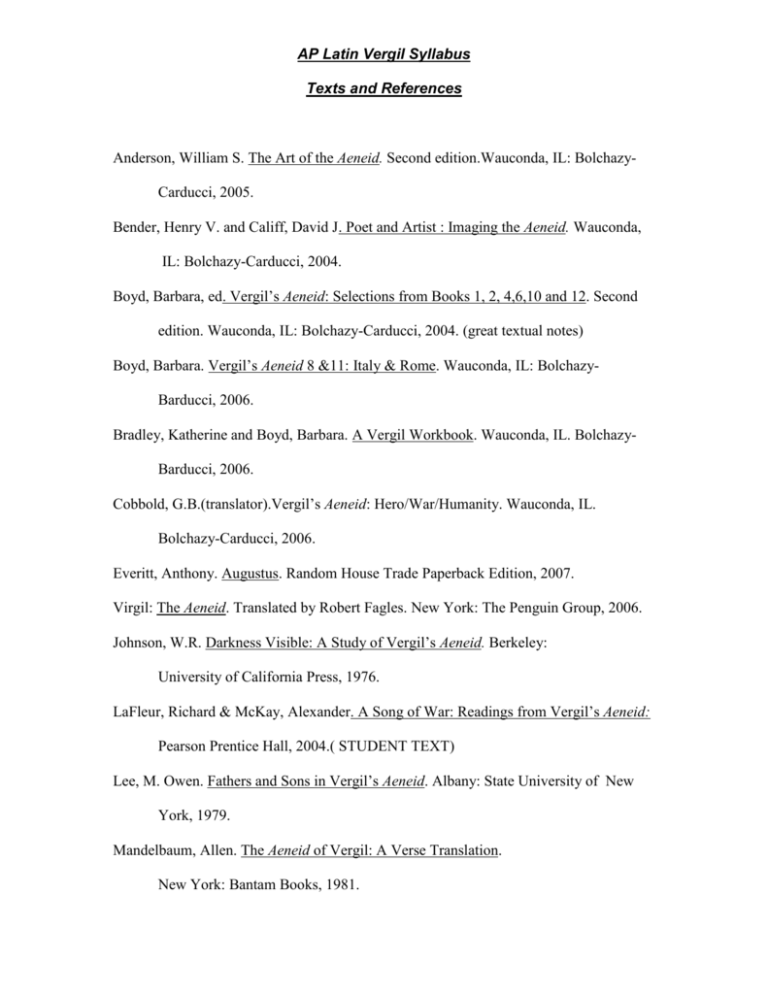
AP Latin Vergil Syllabus
Texts and References
Anderson, William S. The Art of the Aeneid. Second edition.Wauconda, IL: BolchazyCarducci, 2005.
Bender, Henry V. and Califf, David J. Poet and Artist : Imaging the Aeneid. Wauconda,
IL: Bolchazy-Carducci, 2004.
Boyd, Barbara, ed. Vergil’s Aeneid: Selections from Books 1, 2, 4,6,10 and 12. Second
edition. Wauconda, IL: Bolchazy-Carducci, 2004. (great textual notes)
Boyd, Barbara. Vergil’s Aeneid 8 &11: Italy & Rome. Wauconda, IL: BolchazyBarducci, 2006.
Bradley, Katherine and Boyd, Barbara. A Vergil Workbook. Wauconda, IL. BolchazyBarducci, 2006.
Cobbold, G.B.(translator).Vergil’s Aeneid: Hero/War/Humanity. Wauconda, IL.
Bolchazy-Carducci, 2006.
Everitt, Anthony. Augustus. Random House Trade Paperback Edition, 2007.
Virgil: The Aeneid. Translated by Robert Fagles. New York: The Penguin Group, 2006.
Johnson, W.R. Darkness Visible: A Study of Vergil’s Aeneid. Berkeley:
University of California Press, 1976.
LaFleur, Richard & McKay, Alexander. A Song of War: Readings from Vergil’s Aeneid:
Pearson Prentice Hall, 2004.( STUDENT TEXT)
Lee, M. Owen. Fathers and Sons in Vergil’s Aeneid. Albany: State University of New
York, 1979.
Mandelbaum, Allen. The Aeneid of Vergil: A Verse Translation.
New York: Bantam Books, 1981.
McDonough, Christopher, Prior, Richard, and Stansbury, Mark. Servius’ Commentary on
Book Four of Virgil’s Aeneid. Wauconda, IL: Bolchazy-Barducci, 2004.
Perkell, Christine, ed. Reading Vergil’s Aeneid: An Interpretive Guide. Norman:
University of Oklahoma Press, 1999.
Quinn, Kenneth. Vergils’ Aeneid: A Critical Description. Ann Arbor: The
University of Michigan Press, 1968.
Sweet, Waldo E. Vergil’s Aeneid: Books I & II. Oak Park, IL: Bolchazy-Carducci,1983.
Vandiver, Elizabeth. The Aeneid of Virgil.Chantilly, VA.: The Teaching Company, 1999.
Williams, Gordon. Technique and Ideas in the Aeneid. New Haven & London: Yale
University Press, 1983.
Williams, R.D. Vergil: Aeneid I-VI. Newburyport, MA: Focus, 2004.
Williams, R.D. Vergil: Aeneid VII-XII. Newburyport, MA: Focus, 1997.
The teacher will provide information relevant to the course from the texts of his
own library listed above.
EXPECTATIONS
Over the summer students will read the entire Aeneid translated by David West in
English, so that they will know the story of this great epic. The instructor will also give
students basic information about the Iliad and the Odyssey to help students discern the
difference between the Homeric hero and the Vergilian one. While both the instructor and
students can use English translations to facilitate understanding of a passage, the
verbatim copying of a translation is prohibited as it will not prepare the students for the
AP exam. Academic honesty with regard to preparation of one’s own translations is a
foundation of the course.
The instructor requires that students enter the classroom in a timely fashion and
be ready to start the day’s lesson when the bell rings. The instructor assumes that all
students will have fully and carefully translated 15-20 lines a day. Difficulty of
translation does not excuse students from coming to class with untranslated lines. When
students encounter difficulty translating their lines at home, the instructor expects that
each line’s literal definitions be expressed accurately; later, semantics and idiomatic
rendering into English will be worked out in class. The rule to abide by for translation is
as follows: “As literal as possible, as free as necessary.” Students will read and discuss
their translations with the class. Students will have their own notebook with their
translations written below Vergil’s Latin text. {C3- Students have frequent opportunities
to practice reading and translating as literally as possible from Latin to English the
required passages from Vergil’s Aeneid.}
Students are required to render literal translations of the following grammatical
constructions: ablatives absolute, participles, indirect statement, independent and
subordinate usages of the subjunctive, and correct tense and voice of verbs. Students are
required to render translations that honor the case usage employed by Vergil, although
impersonal verbs may be changed to personal verbs and poetic plurals can be rendered
singularly when logic dictates such singularity. Accusatives of respect can also be
translated freely. Thus, anything other than Latin idioms (e.g., accusatives of respect and
impersonal verb constructions) should be rendered as literally as possible in order to
exhibit to the AP test grader that you, the student, have a superior knowledge of Latin
grammar. {C4- Students have frequent opportunities to practice written analysis and
critical interpretation of Vergil’s Aeneid, including appropriate references to the use of
stylistic and metrical techniques by Vergil.}
In addition to literal translations, students will practice sight translations at least
twice a week in order to do well on the multiple choice questions based on sight reading
passages and those from the AP Vergil syllabus. The multiple choice section is comprised
of the following seven kinds of questions: translation, comprehension, grammar,
reference to a specific person, place, or thing mentioned in the text, figures of speech,
scansion and background. Because macrons are not provided, students must notice the
separation of nouns and their adjectives, placement of words, and diction. Soon students
will approach their daily translations as sight translations. They will make learn to make
decisions without constant reliance on the notes provided in their text. Previous AP
exams will enable students to become more proficient. {C6- The course provides frequent
practice in reading Latin at sight.}
Students must scan dactylic hexameter, fully recognizing caesurae, elisions, and
enjambment. In addition, students will memorize and recite short passages exhibiting
knowledge of the sonorous and dramatic value of Vergil’s meter. {C4-Students have
opportunities to practice use of stylistic and metrical techniques by Vergil.}
The instructor will test students’ grasp of rhetorical and poetic devices (chiasmus,
synchysis, hendiadys, metaphor, simile, zeugma, metonymy, alliteration, word picture,
etc.) by means of a test in which students define those terms. Rhetorical and poetic
devices will be emphasized in class discussions and in student journals. Finally, students
will be expected to properly identify these devices on tests.
Students are also expected to keep a weekly journal with their own reflections
about the passages read and discussed during the week. Notebook entries should be
written in a style that reflects the type of interpretive and analytic essays that AP test
graders want students to write on the AP exam. Therefore, notebook essays should
strictly adhere, or be grounded only in the text being discussed; there are to be no
digressions in notebook essays that have no relationship to the text being reflected upon.
In both note book essays and test essays, students should quote Latin lines or phrases to
support their analyses. These quotes should be accurately paraphrased or translated
according to the accepted style of citation on the AP exam. These quotes should come
from the beginning, middle, and end of the passage(s) that are being scrutinized.{C4
Students have frequent opportunities to practice written analysis and critical
interpretation of Vergil’s Aeneid, including appropriate references to the use of stylistic
and metrical techniques by Vergil.}
Upon entry into AP Vergil, students will be tested on their general knowledge of
the epic. The instructor will impart Homeric heroic ideals so that students can understand
Vergil’s conception of the ideal Roman hero and Homer’s conception of the ideal Greek
hero. Students will be expected to know the role played by specific characters of the
Aeneid. Throughout the course, the teacher will bring in passages of the Iliad and the
Odyssey to facilitate students’ knowledge of the Odyssean (books 1-6) and Iliadic books
(7-12) of the Aeneid.
Instructors will help students understand the Augustan Participate and its
concomitant architecture and literature and how they reflect a Roman sense of moral
superiority and the right to rule. Students will also learn how the art, architecture, and
literature of the Augustan Age helped the Emperor Augustus foster a sense of unity of
empire after a century of constant civil war in the Roman world, i.e., the Social Wars, the
civil strife perpetrated by Marius, Sulla, Caesar, Pompey, and, finally, Augustus’ defeat
of Mark Antony. { C5- The course examines the historical, social, cultural, and political
context of Vergil’s Aeneid.} Of course, the instructor must be totally familiar with the
most current AP Latin course description.{ C1- The teacher has read the most current AP
Latin Course Description.}
Assessment
Notebook with journal- 30%
Daily Assessment- 20 %. The teacher will grade daily lines, ensuring that grammatical
structures are rendered in accordance with AP guidelines. Rhetorical and poetic devices
will be noted. Students must demonstrate knowledge of scansion, including elisions,
caesurae, enjambment, and the concept of form= meaning with regard to spondaic lines
and predominantly dactylic ones. In addition, sight translations will be given twice a
week to each student. At times, students will work with their partners to ensure that peer
tutoring and peer learning are taking place during sight translation exercises.
Tests- 30 %
Midterm- 10%. A complete AP Vergil Exam from a previous year will be administered.
The students will then understand fully how their upcoming AP Vergil test will be
graded. We will examine their weaknesses and make plans for improvement.
Final exam- 10%. Another earlier AP Vergil Exam will be administered at least a month
before the actual 2012 AP Vergil Exam. Problems and difficulties will be discussed and
addressed in order to make final preparations for the 2012 AP Vergil Exam.
Pacing for the year and a further discussion of daily class activities
Required Reading of the Aeneid in Latin:
Book I, Lines 1-519 (Rest of book will be read in English.)
Book II lines 1-56, 199-297, 469-566, and 735-805 (rest of book read in English)
Book III Students will read in English.
Book IV lines 1-449, 642-705 (rest of book read in English)
Book V Students will read in English.
Book VI lines 1-211, 450-476, and 847-901(rest of book read in English)
Books VII, VIII, and IX Students will read in English
Book X 420 -509 (rest of book read in English)
Book XI Students will read in English.
Book XII 791-842, 887-952 (rest of book read in English)
Total number of lines read in Latin-1856
{C2- The course is structured to enable students to complete the required reading list, as
delineated in the AP Latin Course description.}
Total Number of Lines 1,856. The rest of the Aeneid will be read in English
translation.
The instructor of this course will strive to follow a pace whereby students
translate 15 lines a day. Students will work on these lines in class in pairs or by
themselves. Most students will need to spend 30 minutes a night (or more) to complete
these lines. Since class lasts for 55 minutes, half of the class will be devoted to discussion
of the previous night’s lines. This daily discussion will focus on a literal translation of the
lines, emphasizing case usage, grammatical forms (participles, gerunds, ablatives
absolute, historical presents, accusatives of respect, syncopated forms, infinitives of
exclamation, etc.), subjunctive usage, indirect statement and other important grammatical
constructions. Also, the teacher will lead students to a better understanding during class
discussions of how poetic/ rhetorical devices and meter contribute to the imagery and
drama of the epic. {C4- Students have frequent opportunities to practice written analysis
and critical interpretation of Vergil’s Aeneid, including appropriate references to the use
of stylistic and metrical techniques by Vergil.}
In the beginning of the year, about 10 lines a day will be translated. However,
once students become faster at translating, 15-20 lines a day will be the daily assignment.
This pace will allow us to take a test every 200 lines, take a mid-term, and a final. We
should have 2 weeks to review for the exam before AP testing starts. It is this instructor’s
experience that it is best if students finish the translations for this course by April 1
because students will soon be missing several days of class for testing in other AP
classes. The pace of 15-20 lines a day ensures that we cross the finish line by April 1.
Students are required to meet with the instructor and fellow classmates for after
school readings in English and in Latin. This will allow us to have in depth discussions of
the overall composition of the Aeneid, the historical context, thorough knowledge of
scanning and reciting dactylic hexameter, and identification and the purpose of poetic
and rhetorical devices.
Student signature ____________________ Parent signature______________________
CALENDAR 2011-2012 WEEKLY TRANSLATION ASSIGNMENTS
August 1-5
Aeneid, I: 1-33
scan 1-11 and recite
August 8-12
I: 34-80
August 15-19
I: 81-123
August 22-26
I: 124-179
August 29-Sept.2
I: 180-253
Sept.6-9
I: 254-296
Sept. 12-16
I: 297-368
Sept. 19-23
School Holiday
Sept. 26-30
I: 369-440
October 3-7
I: 441-519
finish book one in English
Oct. 10-14
II: 1-56
57-198 in English
Oct. 17-21
II: 199-297
Oct.24-28
II: 298-468 in English; 469-525 in Latin
Oct.31- Nov.4
II: 526-566
Nov. 7-11
II: 735-804
Nov.14-18
IV: 1-89
Nov. 21-25
Thanksgiving Holidays Read book five in English.
Nov.28-Dec.2
IV: 90-159
Dec. 5-9
IV: 160-237
Dec. 12-16
AP Practice Exam
Jan.2-6
IV: 238-303
Jan. 9-13
IV: 304-392
Jan. 17-20
IV: 393-448 (449-641 in English)
Jan. 23-27
IV: 642-705
Jan. 30-Feb. 3
VI: 1-76
Feb. 6-10
VI: 77-155
Feb.13-17
VI: 155-211
Feb. 20-24
VI: 450-476 (477-846 in English)
Feb. 27-March 2
VI: 847-901
March 5-9
Read books 7, 8, in English with study guide
March 12-16
IX, X: 1-419 in English
March 19- 23
X: 420-509 (rest of book in English)
March 26-30
XII: 791-842; 887-952
April 2-6
Spring Break: Read books XI and XII in English
April 9-27
567-734 in English
Read book three in English.
AP exam practice (multiple choice/essays/ translation)

